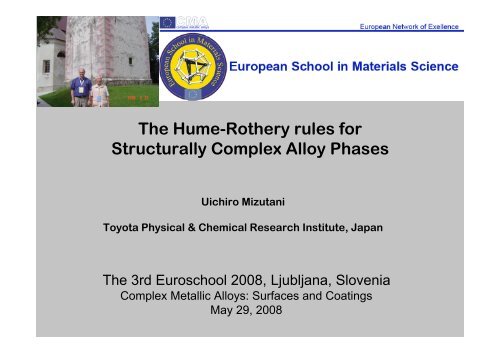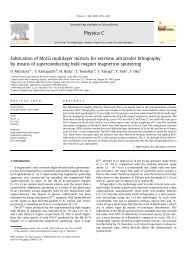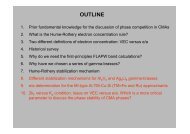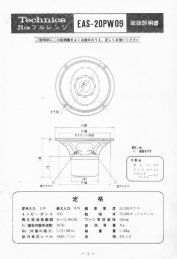The Hume-Rothery rules for Structurally Complex Alloy Phases
The Hume-Rothery rules for Structurally Complex Alloy Phases
The Hume-Rothery rules for Structurally Complex Alloy Phases
You also want an ePaper? Increase the reach of your titles
YUMPU automatically turns print PDFs into web optimized ePapers that Google loves.
<strong>The</strong> <strong>Hume</strong>-<strong>Rothery</strong> <strong>rules</strong> <strong>for</strong><strong>Structurally</strong> <strong>Complex</strong> <strong>Alloy</strong> <strong>Phases</strong>Uichiro MizutaniToyota Physical & Chemical Research Institute, Japan<strong>The</strong> 3rd Euroschool 2008, Ljubljana, Slovenia<strong>Complex</strong> Metallic <strong>Alloy</strong>s: Surfaces and CoatingsMay 29, 2008
Cohesive energies (kJ/mole) of elements in periodic tableLi159Be322B561C711N477O251F84Ne2.1Na108Mg148Al322Si448P332S277Cl135Ar7.7K91Ca176Sc379Ti469V511Cr396Mn288Fe414Co424Ni428Cu338Zn130Ga269Ge374As289Se206Br118Kr11Rb83Sr164Y423Zr610Nb720Mo658TcRu639Rh555Pd380Ag286Cd112In247Sn301Sb259Te193I107Xe15Cs80Ba179La434Hf611Ta781W837Re782Os783Ir670Pt565Au365Hg67Tl181Pb197Bi208Po144AtRnFrRaAcCe460!Th572!Pr373!Pa527!Nd323!U522!Pm!Np440!Sm203!Pu385!Eu174!Am251!Gd399!Cm!Tb393!Bk!Dy297!Cf!Ho293!Es!Er322!Fm!Tm247!Md!Cohesive energy represent an energy needed to separate all atoms in a solid at absolute zero into theassembly of neural atoms. <strong>The</strong> values underlined refer to those either at 298.15 K or at the melting point.<strong>The</strong> values are in the units of kJ/mole converted from the values in the units of cal/mole. C.Kittel,“Introduction to Solid State Physics”, (Third Edition, John Wiley & Sons, New York, 1967), Chapter 3.Yb151!Lu427!Lw!No Lr! !
Electron theory of metals is an essential ingredient to deepenunderstanding of an alloy phase competitionk zFermi sphereE =<strong>The</strong> free electron model!""! $ h 2%# 2m& '2 ( = E(# h2 $2m% (k 2 x+ k 2 y+ k 2 z) = h 2 k 22mk x= 2!n xL" = e ir k # rplane wave(n x= 0, ±1, ±2,±3"" "")k xConstruction of the Fermi sphere. <strong>The</strong> reciprocal space is quantized ! in units of 2#/L in the k x -,k y - and k z -directions and is made up of cubes with edge length 2#/L as indicated in the figure.Electrons of up and down spins occupy the corner of each cube or integer set (n x , n y , n z ) inaccordance with the Pauli principle while making n 2 x +n 2 y +n2z as low as possible. <strong>The</strong> spherewith radius k F represents the Fermi sphere.2 !L2 !L2 !L2 !/Lk Fk y)k F = 3" 2 # e / a&,+ % (.* $ '-e/a: electron concentration defined as an average valency of constituentatoms in an alloy.V a1/ 3
E-k relations (dispersion relation)EThree representations <strong>for</strong> thedescription of the electronic structureE Fk FEDensity of states (DOS)DOS(E) = "EN(E)!0k xFermi surfacek z0!"#$%E Fk x0k Fk yDeparture from the free electron modelNature tries to lower the electronic energy of a systemby expelling electrons at the Fermi level. This is nothingbut the <strong>for</strong>mation of a true or pseudogap at the Fermilevel, as indicated above.
A gain in the electronic energy amounts to several 10 kJ/mol, which is largeenough to stabilize a given phase among competing phasesDOS50~500 meV0.2N(E F ) freeGain in electronic energy, "U /kJ.mole -10-10-20-30-40psuedogap immediately below E Fpseudogap near the bottom of the valence band0 7!"#$% energy E (eV)E F-500100 200 300Width of energy gap, "E/ meV400500Kinetic energy increases in this directionand becomes the maximum at the Fermilevel.Examples to stabilize a system by <strong>for</strong>mation of (pseudo)gap at E F1. A structurally complex phase by increasing the number ofatoms in a unit cell2. A superconductor by <strong>for</strong>ming the superconducting gap3. A quasi-one-dimensional organic molecular metal byintroducing new modulations through de<strong>for</strong>mation of thelattice. This is known as the Peierls transition.
<strong>The</strong> Brillouin zone of Three <strong>Complex</strong> <strong>Alloy</strong> <strong>Phases</strong>II. 1/1-1/1-1/1 approximant, N=160, polyhedron with 84 planes(543)(543)(550)(543)(543)(543)(710)(543)(550)(543)(710)(710)(543)(550)I. gamma-brass, N=52, polyhedron with 36 planesG 2 =18{330}{411}(543)(543)(543)(543)(710)(710)(543) (543)(550)(543)(543)(543)III. Quasicrystal, N is infinite, polyhedron with 60 planesG 2 =50Intensity (arb.units)1110001/2(311111)111100211111221001322101322111332002203040502! (deg.)607080<strong>The</strong> larger the number of atoms in the unit cell, the more the number of zone faces, acrosswhich an energy gap opens. This in turn results in a deeper pseudogap on the DOS. As aresult, the electronic energy can be more efficiently lowered by increasing the number ofatoms in the unit cell.
What is the <strong>Hume</strong>-<strong>Rothery</strong> electron concentration rule!<strong>Hume</strong>-<strong>Rothery</strong> (1926) pointed out a tendency <strong>for</strong> a definite crystal structure to occur at aparticular electron concentration e/a. Mott and Jones (1936) made its first interpretation interms of the Fermi surface-Brillouin zone interaction on the basis of the nearly free electronmodel.N.F.Mott (1905-1996)H.Jones (1905-1986)William <strong>Hume</strong>-<strong>Rothery</strong> (1899-1968){411}{330}<strong>The</strong>re exist two different definitions <strong>for</strong> electron concentration:e/a versus VEC
Various physical properties fall on a universal curve, when plottedagainst the VEC (number of electrons per atom in the valence band)Slater-Pauling curve"Saturation magnetization against VECMatthias ruleSuperconducting transition temperature against VECSeebeck coefficient (µV/K)10050p- and n-type thermoelectric alloysFe 2VAl doped with various elements!"#$!%300 K0Fe 2 VAl-50Fe 2 V(Al 1-x Si x )Fe 2 V(Al 1-x Ge x )Fe 2 (V 1-x Ti x )AlFe 2 (V 1-x Zr x )Al-100Fe 2 (V 1-x Mo x )AlFe 2 (V 1-x W x )Al(Fe 1-x Co x ) 2 VAl &"#$!%(Fe 1-x Pt x ) 2 VAl-1505.9 5.95 6 6.05 6.1electron concentration VECY.Nishino and U.Mizutani (2005)VEC =8 " 2 + 5 "1+ 3"14= 6.0
Electron concentration in the <strong>Hume</strong>-<strong>Rothery</strong> electron concentration rule is notVEC but should be e/a (averaged number of valencies of constituent atoms).e/ae/a(Cu 5Zn 8) = 1" 5 + 2 " 813e/a(Cu 9Al 4) =1" 9 + 3" 413= 2113= 21131Cu IAg IAu I 3/21.421/137/4Zn IICd IIAl IIIGa IIISn IVVEC!VEC(Cu 5Zn 8) =VEC(Cu 9Al 4) =11" 5 +12 " 81311" 9 + 3" 413= 15113= 11113!
Model of Jones <strong>for</strong> the interpretation of the <strong>Hume</strong>-<strong>Rothery</strong>rule on "/# phase trans<strong>for</strong>mation in Cu-Zn system(a)Brillouin zone of fcc(002)(c){111}{110}E F$"U = U fcc #U bcc = {N(E) fcc # N(E) bcc }EdE0W!!K%(111)LX!U fcc-U bcc(10 2 eV atom -1 )e/aBrillouin zone of bcc(b)!H(110)%PNHH.Jones, Proc.Phys.Soc. A49 (1937) 250Difficulties in model of JonesDiscovery of the neck in the Fermi surface of fcc-Cu by Pippard in 1957Ignorance of the Cu-3d band<strong>Hume</strong>-<strong>Rothery</strong> commented in 1961 that “the work of the last ten years has made the theory of alloystructures appear less satisfactory than was the case twenty-five years ago. It is now definitelyestablished that the assumption of a spherical Fermi surface <strong>for</strong> pure Cu is quite unjustified…”.
FLAPW valence band structure and van-Hove singularities in fcc-Cudue to contact with {111} zone planesdue to contact with {200} zone planesdue to overlap across{111} zone planes
EF$E o"U = N bcc (E)(E # E o#bcc )dE # N fcc (E)(E # E o# fcc )dEEF$E o!You can see that the van-Hove singularities are negligibly small in both fcc- and bcc-Cu.<strong>The</strong> band structure energy difference arises essentially from the difference in Cu-3dbands and amounts to about 10 kJ/mole in favor of the bcc structure.
As is clear from the argument above, the interpretation of &/'phase trans<strong>for</strong>mation in the Cu-Zn system is still far from our goal.We believe the situation in complex alloy phasesto be different from that in fcc and bcc Cu,where van-Hove singularities are too small toaffect the total energy.
A pseudogap across the Fermi level plays a key role instabilizing a complex alloy phaseAl-Mn approximantMn-3d/Al-3p bonding statesMn-3d/Al-3p anti-bonding statesT.Fujiwara, Phys.Rev.B 40 (1989) 942---First-principles LMTO band calculations---<strong>The</strong> origin of the pseudogap was attributed to the Mn-3d/Al-3p orbital hybridizationsE F
!We are interested in e/a-dependent phase stabilityOrbital hybridizationsFsBz interactionAl-3pAnti-Bonding energy level LUMOE FBonding energy level HOMOMn-3d2d~4 Å$ F ~4 ÅOrbital hybridization effect would occurnot only in crystals but also in noncrystallinesystems like liquid metalsand amorphous alloys.Resonance of electrons having the wave length $ Fwith a set of lattice planes with spacing 2d.FsBz interaction is unique in well-orderedsystems like crystals and quasicrystals" F = 2#k F$1( e / a) 1/ 3
An increase in the number of atoms in unit cell accompanies an increase inBrillouin zone planesI. bcc, N=2, dodecahedron with 12 planesIV. 1/1-1/1-1/1 approximant, N=160, polyhedron with 84 planes(543)(543)(550)(543)(543)(543){110} N!PH(710)(543)(550)(543)(710)(710)(543)(550)G 2 =2II. fcc, N=4, truncated octahedron with 14 planes{002}G 2 =3 or 4{111}(543)(543)(543)(543)(710)(710)(543) (543)(550)(543)(543)(543)V. Quasicrystal, N is infinite, polyhedron with 60 planesG 2 =50III. gamma-brass, N=52, polyhedron with 36 planesG 2 =18{411}{330}<strong>The</strong> gamma-brass is complex enough to producea sizeable pseudogap at the Fermi level but isstill simple enough to per<strong>for</strong>m the FLAPW bandcalculations with an efficient speed.
Gamma-brasses with the space group P43m and I43m(b)Inner Tetrahedron (IT)Octahedron (OH)(a)Outer Tetrahedron (OT)Cubo Octahedron (CO)26-atom cluster<strong>The</strong> 26-atom cluster <strong>for</strong>ms either bcc or CsCl-structure and contains 52 atoms in the unit cell.
Our objective is to explore if all gamma-brasses listed hereare stabilized via the same mechanism at e/a=21/13Empirical <strong>Hume</strong>-<strong>Rothery</strong> e/a rule <strong>for</strong>gamma-brasses in the past1.61.61.461.61.61Cu IAg IAu I 21/13Zn IICd IIAl IIIGa IIIIn IIISn IVIn literature, all isostructural gamma-brassesabove had been implicitly assumed to bestabilized at e/a=21/13 or the valency of thepartner element to be <strong>for</strong>ced to take a valueto fulfill the total e/a equal to 21/13.
DOS of Cu 9 Al 4 gamma-brass3.0Cu 9Al 4gamma-brass2.5DOS (states/eV.atom)2.01.51.0Cu-3dpseudogap0.50.0-10 -8 -6 -4 -2 E0 F2 4Energy (eV)<strong>The</strong> FsBz interaction is really responsible <strong>for</strong> the <strong>for</strong>mation of the pseudogap?
Principle <strong>for</strong> the extraction of the FsBz interaction from the first-principlesFLAPW (Full-potential Linearized Augmented Plane Wave method) band calculationsAdoption of spherically symmetric muffin-tin potentialkr " a # k (r) = & A lmul(E l , r) + B k lmu˙ l (E l , r)r " alm# k (r) = exp(ik $r)[ ] Y lm($, %)!!" k (E, r) = $ C(k + G hkl )# k+G hkl (E ,r)Ghkl!!" k+Ghkl (E,r) : FLAPW basis function[ ]" k (E, r) = $ C(k + G hkl )exp i(k + G hkl )# rE F!Ghkl12 1,1, 0 ( )(1)FLAPW-Fourier AnalysisWe extract the electronic state k+G hklhaving the largest Fourier coefficient in wavefunction (1) at symmetry point N with the energy eigen-value near the Fermi level. Thisis nothing but the extraction of the set of lattice planes resonating with electron waves.%kH{110}N
Cu 5 Zn 8 and Cu 9 Al 4 gamma-brasses in group 1gamma-brasse/agamma-brasse/agammabrasse/a1Cu 5 Zn 8 21/13 Cu 9 In 4 21/13 Ni 2 Be 11 ?Ag 5 Cd 8 21/13 1 Ag 9 In 4 21/13 Ni 2 Cd 11 ?Ag 5 Zn 8 21/13 Au 9 In 4 21/13 Mn 2 Zn 11 ?2Cu 5 Cd 8 21/13 Ni 2 Zn 11 1.60? Pt 2 Zn 11 ?Au 5 Cd 8 21/13 Pd 2 Zn 11 1.60? Al 8 V 5 1.46?Au 5 Zn 8 21/13 2 Fe 2 Zn 11 1.60? Mn 3 In ?Cu 9 Al 4 21/13 Co 2 Zn 11 1.60?21/133 Ag 5 Li 8?Cu 9 Ga 4 21/13 Ir 2 Zn 11 ?
E-k dispersions and DOS derived from FLAPW <strong>for</strong> Cu 5 Zn 8 gamma-brassCu 5 Zn 8 gamma-brasspseudogapCu-3dZn-3d543210-10 -8 -6 -4 -2 0 2 4E FEnergy (eV)Energy (eV)E FE4E3E2E1E FDOS (states/eV.atom)R.Asahi, H.Sato, T.Takeuchi and U.Mizutani, Phys.Rev. B 71 (2005) 165103%N
E-k dispersions and DOS derived from FLAPW <strong>for</strong> Cu 9 Al 4 gamma-brass5Cu 9 Al 4 gamma-brasspseudogap432Cu-3d10-10 -8 -6 -4 -2 E 0 F 2 4Energy (eV)Energy (eV)E FE8E7E6E5E4E3E2E1E FDOS (states/eV.atom)
FLAPW-Fourier spectra <strong>for</strong> the wave function outside the MT sphere atthe point N at energies immediately below the Fermi levelN" k (E, r) = $ C(k N + G hkl )exp i(k N + G hkl )#rG hkl[ ]!|C i Ghkl/2 |210.10.014242420.0010Cu 5Zn 8gamma-brass !4E=-0.62 eV3 628!IG2 =18/I next =123!|C i Ghkl/2 |20.10.010.00118 40 80 120 160 0 18 40|G 0 | 2 =h 2 +k 2 +l 214242424372698!Cu 9Al 4gamma-brassE=-0.41 eVIG2 =18/ I next = 4580|G 0 | 2 =h 2 +k 2 +l 21201601: {211}, 2: {310}, 3: {321}, 4: {411}+{330}, 5: {332}, 6: {510}+{431}, 7: {521}, 8: {530}+{433}, 9: {611}+{532}<strong>The</strong> Fourier coefficient is extremely large at G 2 =18. This implies that electron waves nearthe Fermi level exclusively resonate with the set of {411} and {330} lattice planes withG 2 =18, resulting in the <strong>for</strong>mation of the pseudogap.
Evaluation of the e/a value by means of the FLAPW-Fourier method---<strong>Hume</strong>-<strong>Rothery</strong> plot---We have so far limited ourselves to the extraction of the largest plane wave component of the FLAPW wavefunction only near the Fermi level and only at the symmetry point N.This technique is now extended to a whole valence band. We need to do this only in the irreduciblewedge of the Brillouin zone. <strong>The</strong> wedge is divided into 200 elements and the electronic state (k i +G)having the largest Fourier coefficient <strong>for</strong> the wave function at energy E in the i-th element isextracted. This is done <strong>for</strong> all elements over i=1 to 200 and an average value of (k i +G) av iscalculated. In this way, a new single-branch dispersion relation E-(k i +G) av <strong>for</strong> electrons extendingoutside the MT sphere is derived in the extended zone scheme.k + G E"N =200$i=1# ik i+ G E<strong>The</strong> variance ( must be small to validate this approach.Once the E-(k+G) is determined, the Fermi diameter 2k F is obtained from the value of 2(k+G) at E F .!irreducible wedge<strong>The</strong> e/a is immediately calculated by inserting theFermi diameter 2k F into the relation below:(e/a) total = " (3N 2k F ) 3N=52:number of atoms in the unit cell
E-{2(k+G)} 2 relations <strong>for</strong> itinerant electrons <strong>for</strong> Cu 5 Zn 8 and Cu 9 Al 4 gamma-brasses---<strong>Hume</strong>-<strong>Rothery</strong> plot---Zn-3d(2k F) 2 =18.47 <strong>for</strong> Cu 5Zn 8(2k F) 2 =18.45 <strong>for</strong> Cu 9Al 4Cu-3d(e/a) total = " (3N 2k F ) 3N=52!e/a=1.60 <strong>for</strong> bothgamma-brasses302520Zn-3dCu-3d! 2 (E)151050-10 -8 -6 -4 -2 0 2 4Energy (eV) E F
Studies of TM 2 Zn 11 (TM=Ni, Pd, Fe, Co) gamma-brasses in group 2gamma-brasse/agamma-brasse/agammabrasse/a1Cu 5 Zn 8 21/13 Cu 9 In 4 21/13 Ni 2 Be 11 ?Ag 5 Cd 8 21/13 1 Ag 9 In 4 21/13 Ni 2 Cd 11 ?Ag 5 Zn 8 21/13 Au 9 In 4 21/13 Mn 2 Zn 11 ?2Cu 5 Cd 8 21/13 Ni 2 Zn 11 1.60? Pt 2 Zn 11 ?Au 5 Cd 8 21/13 Pd 2 Zn 11 1.60? Al 8 V 5 1.46?Au 5 Zn 8 21/13 2 Fe 2 Zn 11 1.60? Mn 3 In ?Cu 9 Al 4 21/13 Co 2 Zn 11 1.60?21/133 Ag 5 Li 8?Cu 9 Ga 4 21/13 Ir 2 Zn 11 ?Ekman (1931) studied the TM-Zn gamma-brasses and proposed that they obeythe <strong>Hume</strong>-<strong>Rothery</strong> electron concentration rule with e/a=1.60, provided that thevalency of the TM element is zero.W.Ekman, Z.Physik.Chem. B 12 (1931) 57
FLAPW-derived E-k relations and DOS <strong>for</strong> Ni 2 Zn 11 gamma-brass5Ni 2 Zn 11 gamma-brassNi-3dZn-3dpseudogap43210-10 -8 -6 -4 -2 0 2 4E FEnergy (eV)E FE2E1DOS (states/eV.atom)
FLAPW-Fourier spectra just below and above thepseudogap in Ni 2 Zn 11 gamma-brassDOS (states/eV.atom)54321Ni 2Zn 11gamma-brass!|C hkl | 210.10.010.0010|G| 2 =1840E= +0.05 eV80 120 160h 2 +k 2 +l 20E F-10 -8 -6 -4 -2 0 2 4Energy (eV)G 2 =18 resonance is active inNi 2 Zn 11 gamma-brass.!|C hkl | 210.10.010.0010|G| 2 E= -1.09 eV40 80 120 160=18h 2 +k 2 +l 2
FLAPW-derived E-k relations and DOS <strong>for</strong> Pd 2 Zn 11 gamma-brassPd 2 Zn 11 gamma-brassPd-4dZn-3dpseudogap54321DOS (states/eV.atom)0-10 -8 -6 -4 -2 E 0 F 2 4Energy (eV)E F
FLAPW-Fourier spectra just below and above thepseudogap in Pd 2 Zn 11 gamma-brassDOS (states/eV.atom)543210Pd 2Zn 11gamma-brass-10 -8 -6 -4 -2 0E F2 4Energy (eV)G 2 =18 resonance is active inPd 2 Zn 11 gamma-brass.!|C hkl | 210.10.010.00101!|C hkl | 20.10.01|G| 2 =1840|G| 2 =18E=-0.11 eV80 120 160h 2 +k 2 +l 2 E=-1.14 eV0.00104080 120|G| 2 =h 2 +k 2 +l 2160
FLAPW-derived E-k relations and DOS <strong>for</strong> Co 2 Zn 11 gamma-brassCo 2 Zn 11 gamma-brasspseudogapCo-3dZn-3d-8 -4 0 E F 4Energy (eV)E F54321DOS (states/eV.atom)0
DOS (states/eV.atom)543FLAPW-Fourier spectra just below and above thepseudogap in Co 2 Zn 11 gamma-brassCo 2Zn 11gamma-brass!|C hkl | 20.10.0120.0010110-8 -4 E0 F4Energy (eV)0.1<strong>The</strong> G 2 0.01=18 resonance stillsurvives only above the Fermilevel in Co 2 Zn 11 . 0.0010!|C hkl | 21|G| 2 =18|G| 2 =1840E= +0.91 eV80 120h 2 +k 2 +l 240 80|G| 2 =h 2 +k 2 +l 2E= -0.20 eV120
FLAPW-derived E-k relations and DOS <strong>for</strong> Fe 2 Zn 11 gamma-brass5Fe 2 Zn 11 gamma-brasspseudogapFe-3dZn-3d43210-10 -8 -6 -4 -2 0 2 4E FEnergy (eV)E FDOS (states/eV.atom)
FLAPW-Fourier spectra just below and above thepseudogap in Fe 2 Zn 11 gamma-brassDOS (states/eV.atom)543210Fe 2Zn 11gamma-brass-10 -8 -6 -4 -2 0E F2 4Energy (eV)<strong>The</strong> G 2 =18 resonance stillsurvives only above the Fermilevel in Fe 2 Zn 11 .!|C hkl | 20.0010 40!|C hkl | 210.10.011|G| 2 =180.10.01|G| 2 =180.0010 40E=+1.04 eV80 120 160h 2 +k 2 +l 2E=+0.025 eV80 120 160h 2 +k 2 +l 2
E-(k+G) 2 relations <strong>for</strong> itinerant electrons <strong>for</strong> TM 2 Zn 11 (TM=Ni, Pd, Co, Fe) gamma-brasses---<strong>Hume</strong>-<strong>Rothery</strong> plot---(2k F) 2 =19.36 <strong>for</strong> Ni 2Zn 11=19.27 <strong>for</strong> Pd 2Zn 11(e/a) total = " (3N 2k F ) 3N=52!e/a Ni-Zn =1.72e/a Pd-Zn =1.70(2k F) 2 =19.5 <strong>for</strong> Co 2Zn 11=20.0 <strong>for</strong> Fe 2Zn 11(e/a) total = " (3N 2k F ) 3N=52!e/a Co-Zn =1.73e/a Fe-Zn =1.80
Gamma-brasses in group 1 obey the <strong>Hume</strong>-<strong>Rothery</strong> e/a law with e/a=21/13|G| 2 deducedfrom the FLAPW-Fourier methodCu 5Zn 818Cu 9Al 418Ni 2Zn 11(2k F) 2 deduced<strong>for</strong>m the H-R plot18.47 18.45 19.36 19.27 19.5 20.0(e/a) total1.60 1.60 1.72 1.70 1.73 1.80(e/a) TM0.96 0.97 0.15 0.07 0.26 0.7018Pd 2Zn 1118Co 2Zn 11A pseudogap<strong>for</strong>med below E FX XFe 2Zn 11!!VEC11.68.511.711.711.53811.385group (1) group (2)<strong>The</strong> <strong>Hume</strong>-<strong>Rothery</strong> stabilization mechanism refers to the mechanism, in which apseudogap is <strong>for</strong>med across the Fermi level as a result of electron waves resonatingwith a particular set of lattice planes and thereby the particular e/a value is specified.
Summary <strong>for</strong> gamma-brasses in groups 1 and 2gamma-brasse/agamma-brasse/agammabrasse/a1Cu 5 Zn 8 1.60 Cu 9 In 4 21/13 Ni 2 Be 11 ?Ag 5 Cd 8 21/13 Ag 9 In 4 21/13 Ni 2 Cd 11 ?Ag 5 Zn 8 21/13 Au 9 In 4 21/13 Mn 2 Zn 11 ?12Cu 5 Cd 8 21/13 Ni 2 Zn 11 1.72 Pt 2 Zn 11 ?Au 5 Cd 8 21/13 Pd 2 Zn 11 1.70 Al 8 V 5 1.46?Au 5 Zn 8 21/13 Fe 2 Zn 11 1.80 Mn 3 In ?Cu 9 Al 4 1.60 Co 2 Zn 11 1.7321/1323 Ag 5 Li 8?Cu 9 Ga 4 21/13 Ir 2 Zn 11 ?








